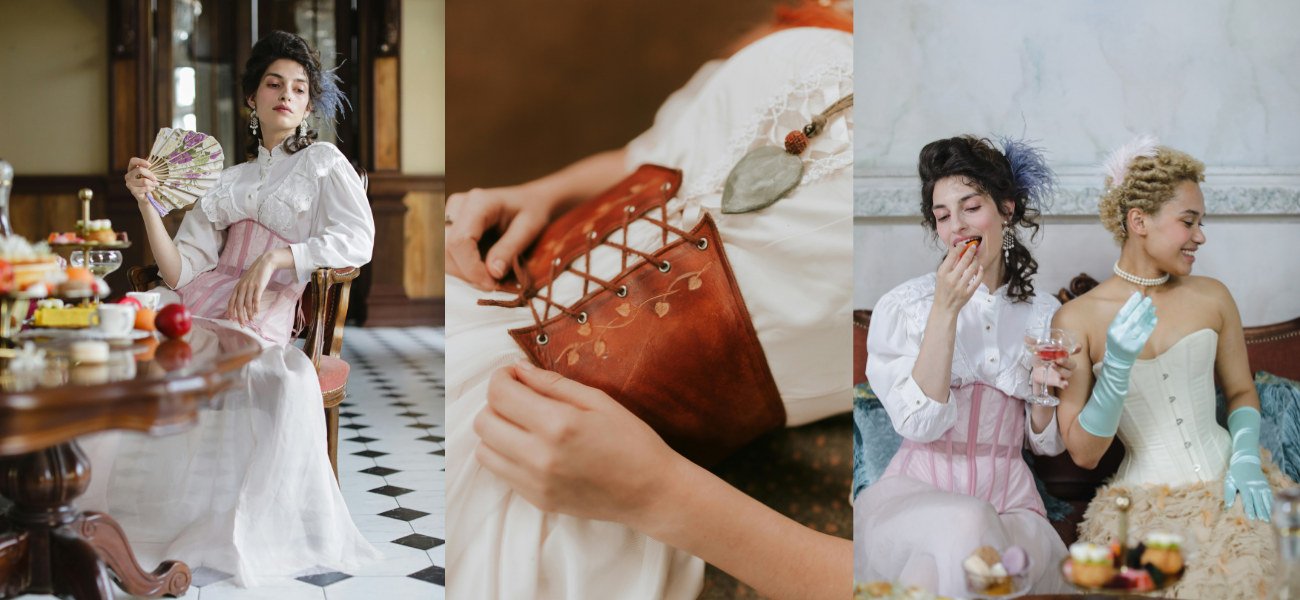- May 23, 2025

The 18th -19th Centuries: Lingerie as Status, Structure, and a Strategy for Survival
In the 18th and 19th centuries, lingerie became a complex ritual — shaping bodies, training girls, and silently signaling class. Beneath the lace and boning was a deeper story: one of discipline, control, and the first whispers of resistance.
After theatrical Baroque, women’s fashion didn’t become simpler — on the contrary, it entered its most formalized and socially loaded phase.
In the 18th and 19th centuries, women’s underwear evolved into a daily routine of body control, discipline, and social status in addition to being a symbol of beauty.
In the past, dressing entailed practically constructing oneself layer by layer.
Even putting on the undergarments took at least 20-30 minutes and that was before the dress arrived.
The Corset Remained — but Became Slightly More “Practical”
The corset’s structure eventually changed, but it was still the primary instrument used to shape the feminine body.
- In the 18th century, it was still stiff, straight, with a pointed lower edge, shaping the torso into a cone. The waist was cinched and the bust lifted.
- However, it was no longer only for balls; for upper-class ladies, it had become the standard. Even young girls started wearing corsets early — it was believed this trained posture and character.
New variations appeared:
- Ballet or “visiting” corsets are designed for brief events and are lighter than formal ones with better elaboration.
- Softer materials are used to create night corsets, which keep the body in form while you sleep.
- Children’s or adolescent educational corsets that gradually shaped the silhouette.
All of this reinforced the idea that the female body was a project to be perfected.
An advertisement for Swanbill corsets in London, c.1897.

The More Layers — The Better
The female body was “dressed” in many layers of lingerie, each of which had a specific purpose:
- Chemise — a thin linen or batiste shirt worn directly on the body. It absorbed sweat and protected the corset.
- Corset — a lady may switch out her corset up to three times a day, depending on her situation and the event on this day.
- Petticoats are volume-enhancing underskirts. In warmer climates, use cotton; in colder climates — wool.
- Pockets — tied around the waist and hidden under the skirts; before purses, they held combs, mirrors, handkerchiefs.
- Wide hips or a raised rear are examples of profile-shaping framework inserts called bustle or paniers.
- Stockings — knee-high socks held by silk or ribbon garters.
- Drawers are women’s pants that first appeared in the 19th century and have an exposed crotch for hygienic reasons.
This elaborate ensemble restricted movement but demonstrated belonging to “proper society.”
An advertisement for Sansflectum crinolines in London, c.1864.

Lingerie as a Language of Status and Morality
Lingerie in this era evolved from “hidden” apparel to a covert social class language:
- Because layer = fabric = effort = money, having more layers signified being wealthy.
- Using handcrafted lace, exquisite French batiste, and embroidery was more about stating, “I am a woman who is cared for,” than it was about aesthetics.
- Their mistresses were clothed, cleaned and pressed by maids. If you dressed yourself, you were a widow or a servant.
Women’s lingerie became part of the infrastructure of daily life.
The 19th Century: When the Body Became an “Hourglass”
In the 19th century, a curvature between the hips, waist, and breast took the place of the straight torso as the preferred form.
New elements were introduced:
- The busk was a front plate made of metal, occasionally wood, that supported the torso.
- Steel boning — steel stays replaced whale bones, offering better shape but still being rigid.
- Early kinds of health corsets were designed to preserve form without causing excessive compression. They frequently featured ventilation holes, were shorter, and had fewer laces.
These corsets did not change a woman’s body; instead, they supported the waist and bust.
New lingerie items also appeared:
- A camisole is a light top composed of natural cloth that resembles a tank. Worn under the corset for comfort and hygiene. Often decorated with lace.
- Combination: a cross between drawers and a shirt. It appeared to be an unsupported, long, thin bodysuit. Created for ease of use.
- Bust pads — soft inserts made of wool or cotton placed into the corset or top to shape fuller-looking breasts.
These products are the direct forerunners of contemporary, aesthetically pleasing, and useful underwear.
Lingerie as Silence That Speaks Loudly
During this time, women’s lingerie was more than just clothing. Every fold, lace, and layer of fabric in this silent journal of the era described a woman’s movements, breathing, silence, and dreams.
However, a silent protest sprang out of this excess, from this beauty that limited freedom. Quiet, yet certain. a desire to wear what one feels, not what society expects, and to breathe deeply.
So lingerie of this period isn’t only about silk, boning and lace. It’s about a path. A path back to oneself.
And for that reason, things will alter in the coming century. Because a woman who has finally realized her power cannot be held back by even the tightest corset.
We’ll go into the 20th century in the following section, when lingerie evolved into a manifesto of liberation.
With love – your Moonlit team
